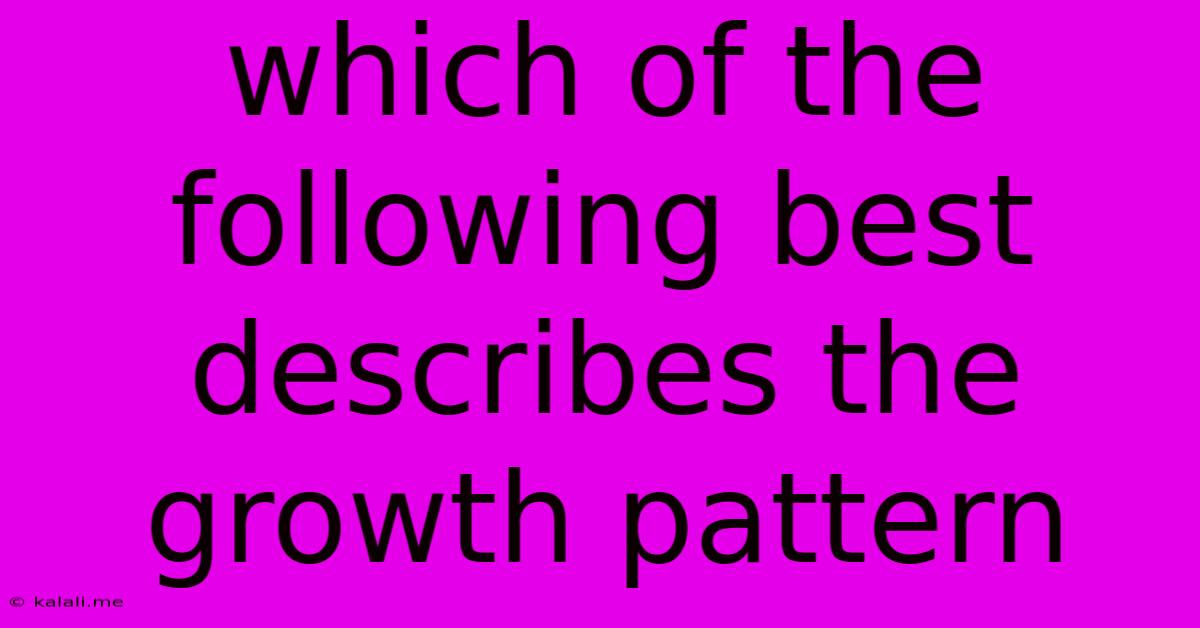Which Of The Following Best Describes The Growth Pattern
Kalali
Jun 13, 2025 · 3 min read

Table of Contents
Which of the Following Best Describes the Growth Pattern? A Deep Dive into Growth Models
Understanding growth patterns is crucial in various fields, from biology and economics to technology and finance. Whether you're analyzing population dynamics, market trends, or the spread of an epidemic, identifying the underlying growth model is key to accurate prediction and informed decision-making. This article explores different growth patterns and helps you determine which best describes a given set of data. We'll examine linear, exponential, logarithmic, and sigmoid growth, highlighting their characteristics and providing practical examples.
Understanding Different Growth Patterns:
Growth patterns can be broadly categorized into several types, each with its unique characteristics and implications:
1. Linear Growth: Steady and Predictable
Linear growth represents a constant rate of increase over time. The growth amount remains the same in each period. This is often represented by a straight line on a graph.
- Characteristics: Constant rate of change, predictable, easily modeled.
- Example: A savings account with a fixed annual interest rate (ignoring compounding) exhibits linear growth. The amount added each year is the same.
- Formula: y = mx + c, where 'm' is the constant rate of change and 'c' is the initial value.
2. Exponential Growth: Rapid and Unconstrained
Exponential growth involves a constant percentage increase over time. The growth rate accelerates as the quantity increases, leading to a rapid increase in size.
- Characteristics: Rapid acceleration, unpredictable in the long term, often unsustainable.
- Example: Uncontrolled population growth, the spread of a virus in the early stages of an epidemic, or compound interest.
- Formula: y = a * b<sup>x</sup>, where 'a' is the initial value, 'b' is the growth factor (1 + growth rate), and 'x' is time.
3. Logarithmic Growth: Slowing Down Over Time
Logarithmic growth is the inverse of exponential growth. It starts rapidly but slows down as it approaches an upper limit or asymptote.
- Characteristics: Initially rapid, then progressively slower, approaches a maximum value.
- Example: Learning a new skill – initial progress is rapid, but improvement slows as you approach mastery. The increase in the height of a tree as it matures.
- Formula: y = a * ln(x) + b, where 'a' and 'b' are constants.
4. Sigmoid Growth (S-Curve): Limited Growth with an Inflection Point
Sigmoid growth, also known as S-curve growth, combines features of exponential and logarithmic growth. It starts slowly, then accelerates exponentially before slowing down again as it approaches a carrying capacity or limit.
- Characteristics: Initial slow growth, followed by rapid growth, then slowing growth as it approaches a limit. Characterized by an inflection point where the growth rate is at its maximum.
- Example: The adoption of a new technology, the growth of a population in a limited environment, or the growth of a company in a saturated market.
- Formula: More complex than linear, exponential, or logarithmic models; often modeled using logistic functions.
Choosing the Right Growth Model:
Determining the best growth model depends on the specific context and the available data. Consider these factors:
-
Visual Inspection: Plot your data on a graph. A linear relationship will appear as a straight line, exponential growth as a rapidly curving upward line, logarithmic as a gradually flattening curve, and sigmoid as an S-shaped curve.
-
Rate of Change: Analyze the rate at which the quantity is increasing. A constant rate suggests linear growth, while an increasing rate suggests exponential growth.
-
Data Analysis Techniques: Statistical methods like regression analysis can help determine the best-fitting model for your data.
Conclusion:
Understanding the different growth patterns and their characteristics is crucial for accurate predictions and informed decision-making. By carefully analyzing the data and considering the context, you can select the appropriate growth model to gain a clearer understanding of the underlying dynamics. Remember to always consider the limitations of each model and interpret the results cautiously.
Latest Posts
Latest Posts
-
Which Of The Following Is Abiotic
Jun 14, 2025
-
Select All The True Statements About Temperate Coniferous Forests
Jun 14, 2025
-
Rest Mass Energy Of A Proton
Jun 14, 2025
-
Energy Stored In The Bonds Between Atoms Is Called
Jun 14, 2025
-
Which Statement About Cells Is True
Jun 14, 2025
Related Post
Thank you for visiting our website which covers about Which Of The Following Best Describes The Growth Pattern . We hope the information provided has been useful to you. Feel free to contact us if you have any questions or need further assistance. See you next time and don't miss to bookmark.